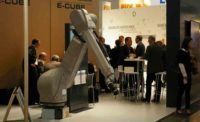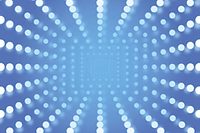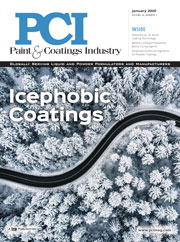UV LED Promises More-Efficient Curing Processes

Ultraviolet (UV) technologies have long been leveraged for a variety of commercial and industrial uses, ranging from irradiating bacteria, playing Blue-Ray DVDs, curing surface coatings, to protecting surfaces from scratches or corrosion. UV curing is undergoing an important shift, with UV LED technology emerging as an appealing alternative to more traditional light sources, like mercury lamps, in both industrial and commercial procedures.
In contrast to mercury lamps, which emit a broad spectrum of UV photons, the promise of UV LED technology lies in its long lifetime and higher efficiency. With cost savings and manufacturing throughput concerns dictating purchasing decisions, more manufacturers are acknow-ledging the benefits of this upstart technology. This article explores the current state of UV LEDs and the advantages of UV LEDs for curing processes.
UV LED benefits are significant, yet some organizations may find implementation a challenge at this point in the technology’s maturity. Before replacing traditional UV-curing techniques with LED solutions, an organization should consider that UV LEDs are not necessarily suitable for all applications due to their use of only the UVA spectrum, in addition to a potentially high initial investment cost and the higher cost of LED-compatible chemistry. Taking these parameters into consideration, the best curing applications for today’s UV LED technology are those with small and mid-size curing area requirements, like most inkjet printing tasks, curing of coatings, glue and adhesives, and some specific semiconductor applications.
UV LED Benefits
Weighing the pros and cons of UV LEDs against traditional UV lamps is similar to comparing LEDs to traditional lamps in the visible spectrum.
- Long lifetime: With a typical lifetime of over 20,000 hours, UV LEDs easily outperform mercury lamps by a factor of 10 or more. As a result, maintenance of their hosts (such as UV ink jet printers) becomes much easier with far less downtime. This reduces operational costs and drives a quicker return on investment. However, to achieve long LED lifetime, especially with UV LEDs, good packaging technology is essential.
- Low energy consumption: Since most of the radiation emitted by mercury UV lamps is unusable wavelength (i.e., visible or infrared radiation), the energy efficiencies delivered by these lamps pales in comparison to LEDs. In contrast, LEDs only emit their radiation in a narrow wavelength band, resulting in a higher concentration of usable UV wavelengths.
- Compact and flexible design: A high-powered LED semiconductor die is typically only 1 x 1 mm2, making LED lamps more compact for easier integration and ideal for small applications. Specific shapes and configurations of the LED lamp can be installed into smaller, specialized equipment such as a curing device for 3D objects.
- Minimal heat production: Since LEDs emit a narrow band of radiation, UV LED lamps will not emit infrared heat or other unnecessary radiation. In addition to the efficiency and energy saving benefits, this is a major advantage for heat-sensitive substrates such as thin plastic, foil or wood, where infrared heat could warp or negatively impact the substrate during the curing process.
- Ozone free: As UV LEDs emit in the UVA range, they do not produce any ozone and do not require an ozone ejection system. In addition to the environmental benefits, this simplifies the curing technology by minimizing the amount of parts required and mitigating additional opportunities for breakage and, thus, downtime.
- Dimmable: LEDs can easily be dimmed by adjusting the electrical current or utilizing pulse width modulation.
- Easy on and off switching: Mercury lamps take time to “warm up” and stabilize. Switching them on and off can shorten their lifetime. In contrast, LEDs can easily be switched on or off without any negative impact on their lifetime.
- No high-voltage power required: LED drivers and power supplies are relatively easy to design in comparison to the high-power supplies required for traditional lamps, which need triggering systems. As a result there is also no need for expensive electrical protection systems.
- Free of hazardous materials: Since LEDs do not contain mercury, lead or other hazardous materials, they are extremely environmentally friendly.
A New UV LED Module
To meet a growing demand for UV LED-curing options and for customers looking to enjoy the variety of benefits, Excelitas Technologies launched the CurX™ UV LED module in early 2013. CurX, an LED-based, high-power, UV light source for UV curing, was developed specifically for applications such as curing coatings, adhesives, glues, varnishes and for digital ink printing, screen printing, flexo and offset printing.
CurX is a linear, scalable “flood” module for area curing available in 365 nm, 385 nm and in 365 nm and 385 nm ranges of UV output. It incorporates long-lasting, mature LED technology from Nichia and delivers up to 18 W/cm² at 385 nm and 14 W/cm² at 365 nm, respectively. The module also features a water cooling system that delivers a stable operating temperature for maximum performance. It is comprised of a ceramic substrate with multiple UV LED dies, a driver and controller for fast switching and easy dimming. The module is fully customizable to meet specific needs of customers, requires no mechanical shutters and, because it is LED based, is mercury free as well as RoHS compliant.
For more information on the benefits of UV LED technology for curing, visit www.Excelitas.com.
Looking for a reprint of this article?
From high-res PDFs to custom plaques, order your copy today!








